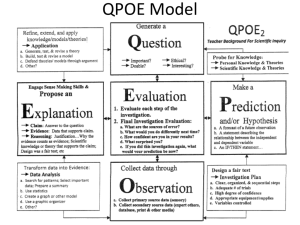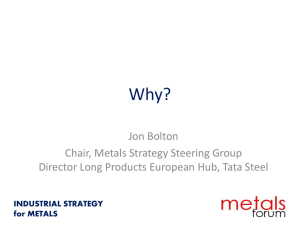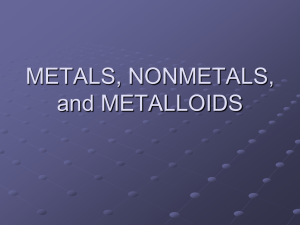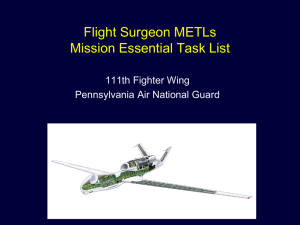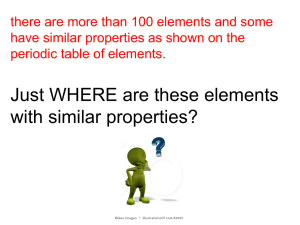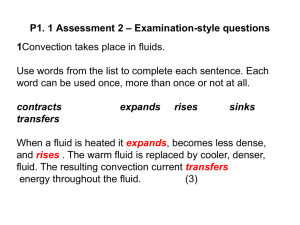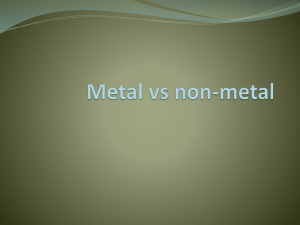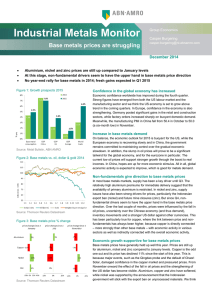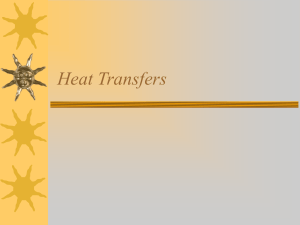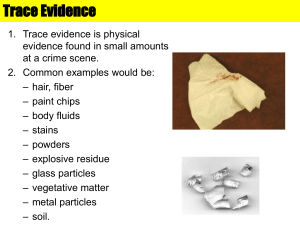File
advertisement
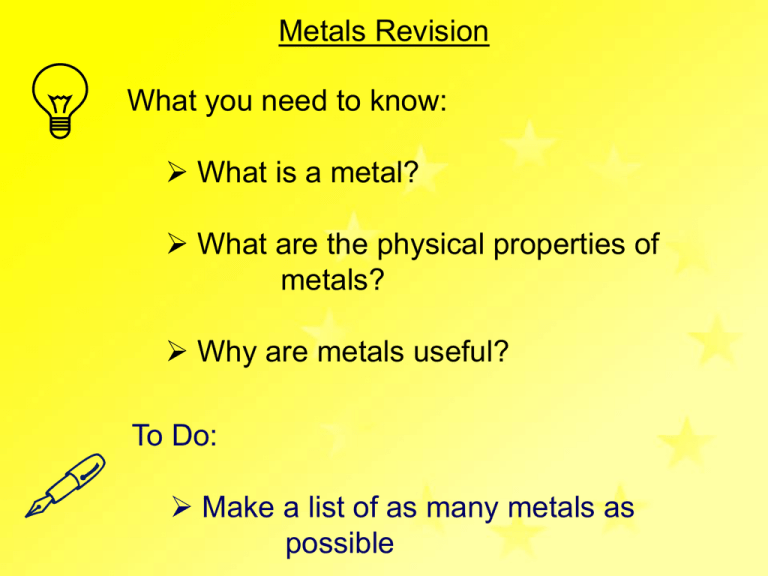
Metals Revision What you need to know: What is a metal? What are the physical properties of metals? Why are metals useful? To Do: Make a list of as many metals as possible To Do: Complete the Properties of Metals worksheet Lustrous All metals are shiny when polished or freshly cut Flexible Metals do not break – they bend Ductile Metals can be drawn into wires Malleable Metals can be hammered into sheets Sonorous Metals ring like a bell when hit - they do not make a dull thud Electrical conductor Thermal conductor All metals conduct electricity Metals allow energy to flow through them, causing heating Which of the following are NOT properties of most metals? strong magnetic brittle high melting point hard Which is the odd one out? B C A Iron Cobalt Copper D Copper is non-magnetic – iron, cobalt and nickel are magnetic Nickel Which is the odd one out? A Antimony B C Palladium Arsenic D Palladium is the only metal – the others are non-metals Graphite Which is the odd one out? A C B Iridium Aluminium Titanium Mercury is liquid at room temperature – the others are solids at room temperature D Mercury Which is the odd one out? B A Aluminium C Bronze D Brass Electrum Aluminium is an element – the others are mixtures of two or more elements Which is the odd one out? A B Sodium Potassium D Lithium C Calcium Calcium is in Group 2 – the others are in Group 1 of the Periodic Table Which is the odd one out? B C A Silver Tin Copper D Tin is only found as a compound – the others often occur naturally as elements Gold Which is the odd one out? A B Sonorous D Magnetic C Malleable Good Thermal Conductor Only cobalt, nickel and iron are magnetic – the others are properties of most metallic elements Which is the odd one out? B C A Selenium Calcium Palladium D Selenium is a non-metal – the others are metals Zinc Which is the odd one out? B C A Iron Thallium D Magnesium Zinc Thallium is extremely toxic – you need small quantities of the others in your diet to remain healthy Which is the odd one out? B C A Molybdenum Copper D Tungsten Yttrium Copper has been known since ancient times – the others were discovered in the 18th Century Complete the exercise on the Using Metals worksheet in your exercise book Write in full sentences Metals are good thermal conductors Most metals have high melting points 1. Saucepans are made of copper, iron, steel or aluminium Metals are good electrical conductors Most metals are ductile... ... they can be drawn out into wires 2. Electrical wires are made of copper Most metals are flexible Most metals are flexible 3. Springs are usually made of steel (an alloy of iron) Metals are lustrous... ... shiny when polished or freshly cut Most metals are ductile 4. A lot of jewellery is made of gold Most metals are malleable... ... they can be beaten flat into sheets Most metals are sonorous... ... they ring when hit, rather than make a dull thud 5. Bells are made of bronze (an alloy of copper and tin) or brass (an alloy of copper and zinc) Most metals are strong Because metals are flexible, buildings with a metal frame have some ‘give’ in them... ... meaning that they survive better during earthquakes 6. The framework of skyscrapers is made of iron or steel girders Iron and steel are much lighter than brick or stone so metalframed buildings can be taller than masonry buildings Metals are good electrical conductors Most metals have a high melting point (The filament glows because it gets very hot – 2000 to 3000 ˚C) 7. The filament in light bulbs is made of tungsten Most metals are hard The harder the blade is, the less quickly it goes blunt 8. Saw blades are made of steel Most metals are malleable... ... so the lead flashing can be moulded to the contours of the roof 9. Flashing – the joins on roofs are waterproofed with sheets of lead Most metals are NOT magnetic Only iron, nickel and cobalt (and their alloys) are magnetic If we made the casing of a compass from a magnetic metal it would shield the compass needle from the Earth’s magnetic field... 10. The casing on compasses is made of brass or aluminium ... so the compass would not work! Copy and complete the notes below, filling in the blanks There 92 naturally occurring elements in the Periodic _______ Table: metals the majority of these elements are ______ left and the centre of the The metals are found on the _____ Periodic Table physical and chemical properties Metals share many _________ Mercury is the only metal which is liquid at room _______ temperature cobalt are the only elements which are Iron, nickel and ______ magnetic ________ What you need to know: What is a metal? What are the physical properties of metals? Why are metals useful?
